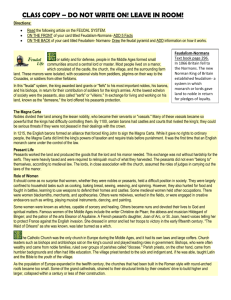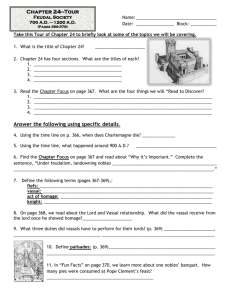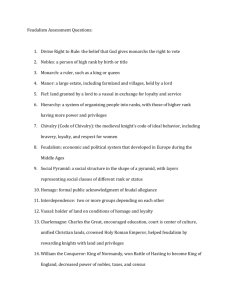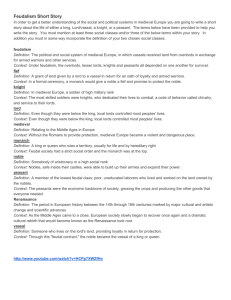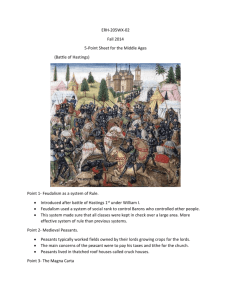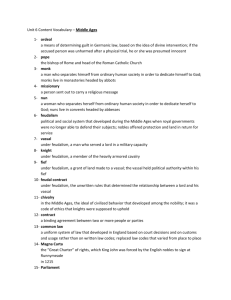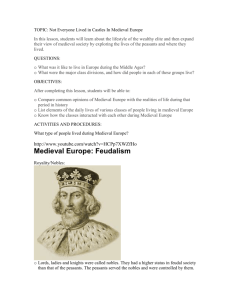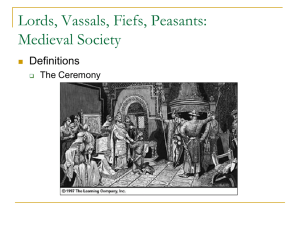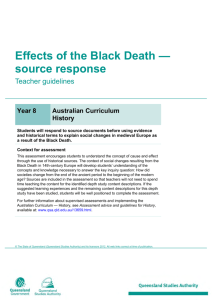vassals - ChelcieTuell
advertisement
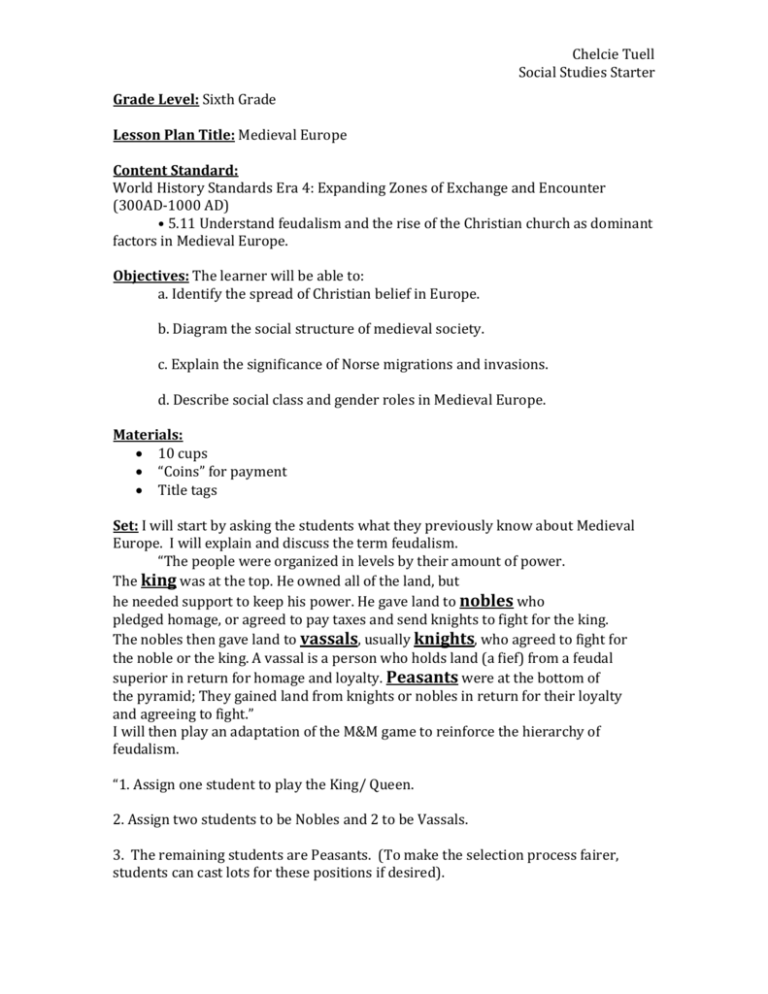
Chelcie Tuell Social Studies Starter Grade Level: Sixth Grade Lesson Plan Title: Medieval Europe Content Standard: World History Standards Era 4: Expanding Zones of Exchange and Encounter (300AD-1000 AD) • 5.11 Understand feudalism and the rise of the Christian church as dominant factors in Medieval Europe. Objectives: The learner will be able to: a. Identify the spread of Christian belief in Europe. b. Diagram the social structure of medieval society. c. Explain the significance of Norse migrations and invasions. d. Describe social class and gender roles in Medieval Europe. Materials: 10 cups “Coins” for payment Title tags Set: I will start by asking the students what they previously know about Medieval Europe. I will explain and discuss the term feudalism. “The people were organized in levels by their amount of power. The king was at the top. He owned all of the land, but he needed support to keep his power. He gave land to nobles who pledged homage, or agreed to pay taxes and send knights to fight for the king. The nobles then gave land to vassals, usually knights, who agreed to fight for the noble or the king. A vassal is a person who holds land (a fief) from a feudal superior in return for homage and loyalty. Peasants were at the bottom of the pyramid; They gained land from knights or nobles in return for their loyalty and agreeing to fight.” I will then play an adaptation of the M&M game to reinforce the hierarchy of feudalism. “1. Assign one student to play the King/ Queen. 2. Assign two students to be Nobles and 2 to be Vassals. 3. The remaining students are Peasants. (To make the selection process fairer, students can cast lots for these positions if desired). Chelcie Tuell Social Studies Starter 4. Tell the students that one of the Nobles has a bigger estate than the other, and split the Peasants unequally, such that about 1/3 answers to the Vassal for one of the Lords (Lord A) while the other 2/3 of the Peasants live on the estate of "Lord B' and so answer to his / her Vassal. 5. Give each Peasant a plastic cup with exactly ten (eight in my demonstration) M&Ms in it. Let them know that they are not to touch the M&M’s until instructed. Tell the students that the M&M’s represent the crops from the land that the Peasants have tended. Then tell the Peasants that they must pay for the protection that they receive from their Lords with their crops. Their assigned Vassals will confiscate seven (five in my demonstration) M&M’s (for classes under 20 students, have Vassals confiscate seven M+Ms to make this work better) from each Peasant in that Noble’s fiefdom. 6. From each Peasant’s payment, the Vassal may keep two of the M&Ms but he / she must give five (three in my demonstration) of them to his Noble to pay for his loyalty. 7. From each of the Vassal’s payment, the Noble may keep two (one in my demonstration) M&Ms for his / her services but must give the remaining three (two in my demonstration) pieces to the King / Queen. 8. At the end of the exercise the Peasants should each have the fewest M+Ms and the King / Queen should have the most. 9. Ask each different role or students how they feel about what they received. 10. If desired a discussion of the church and its power could be added here. In the middle ages, tithing (in which the biblical suggestion that 10% of what one earned should be provided to the church) was taken very seriously. Have the students calculate how much money (M+Ms) would have gone to the church had everyone in the group tithed their income to the church. Given that money and power are closely related in most social systems, have the students discuss the implications of this for the power of the church during this period. 11. Ask the students if they think that the Feudal System was fair and why / why not?” Lesson Outline: Throughout the rest of the lesson, students will learn more about medieval times and the culture. Students will do a more in depth research assignment about the feudal system and the social class system in groups. Students will analyze the roles of each social class: the pope/church, kings/queens, nobility, vassals/knights, peasants, and serfs in their research projects, as well as gender roles and expectations. Each group will collect images, photos, illustrations, and texts that report to each social class and gender role and present their findings. As a class, students will come up with a summary of each social class’ and gender roles Chelcie Tuell Social Studies Starter and jobs and make a chart to stand as their notes, along with the hierarchal pyramid that I will pass out. Students will also be learning about the Bubonic Plaque and it’s affect on everyone. I will sing the children’s’ song “Ring around the Rosie” and ask students what a kid’s song has to do with the Black Plague. Ring Around the Rosie: “ring around the rosie” = a red, round rash that’s the first symptom of the disease; It normally turns black later ‘Ashes, ashes” = words in the funeral Mass: “Ashes to ashes, dust to dust” · or “Achoo, Achoo” =imitation of sneezing sound of infected person ‘A pocket full of posies’ = the practice of putting flowers in their pockets to ward off the disease and the smell of dying people ‘We all fall down’ = the many people who die from the plague and the fact that it affects all classes of people.” Students will then look at pictures showing the Black Plague. “The disease killed approximately 25 million people in Europe and Asia and is thought to have been carried by fleas that lived on rats. Rats lived everywhere, especially in towns, so the disease spread very quickly. People of this time knew nothing about germs and how they spread disease. People came up with many reasons about why they were being inflicted with this deadly disease. The most accepted reason was that it was a sign of displeasure from God. People who developed the disease developed “buboes,” which are swellings in the armpit and neck. These swellings often turned black, which is how it got the name of the Black Death. The disease is incurable, but many people try many different, and some very obscure, treatments. Some people did survive, but most died. The Black Death upset the feudal system because it created a lack of workers. Peasants soon found themselves in high demand and their wages went up.” Sources: Feudalism in Medieval Europe http://gcuonline.georgian.edu/wootton/Medieval.htm Medieval Lessons and M&M Game http://users.manchester.edu/Student/SRKauffman/professionalwebsite/MiddleAg esLessons.pdf Medieval Times: Connections Across the Curriculum http://teachingrocks.ca/wp-content/uploads/2012/06/med-times.pdf Chelcie Tuell Social Studies Starter

